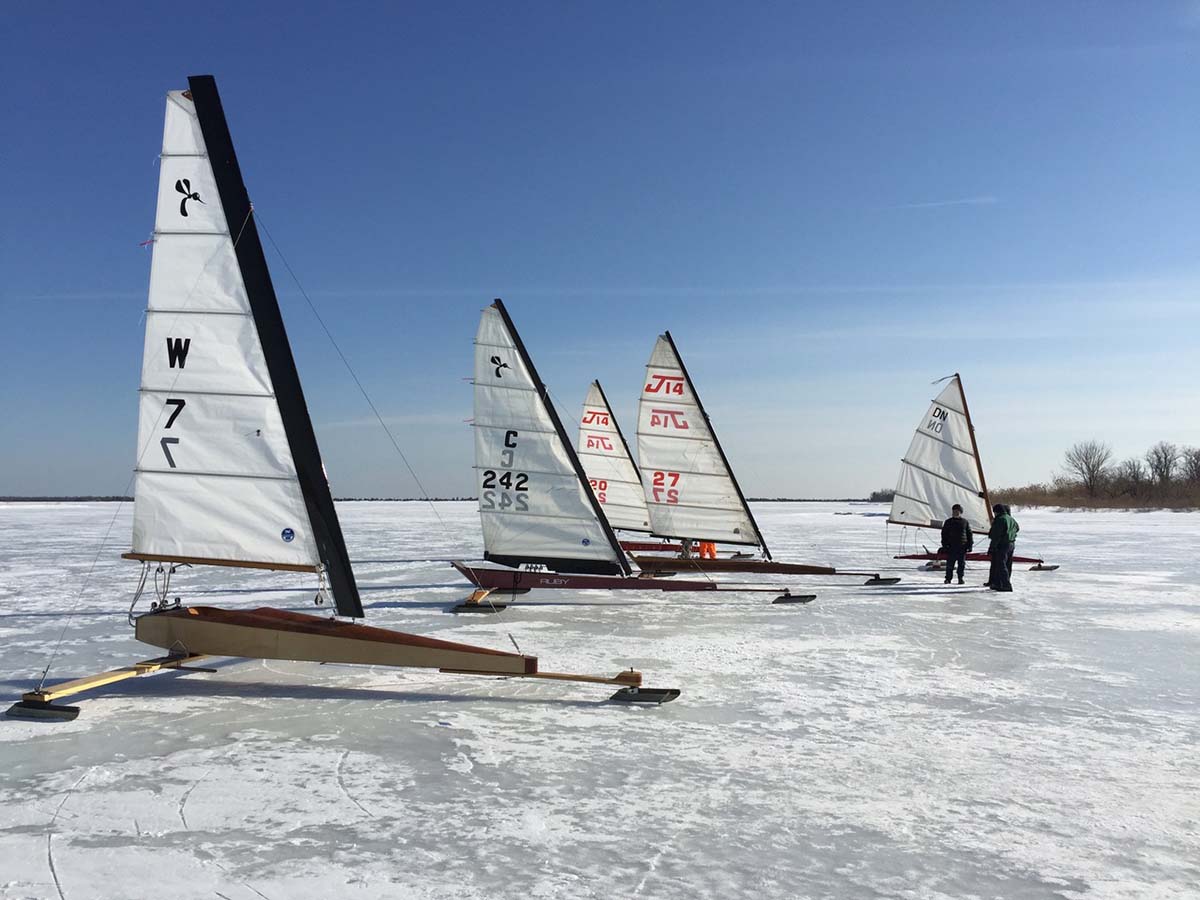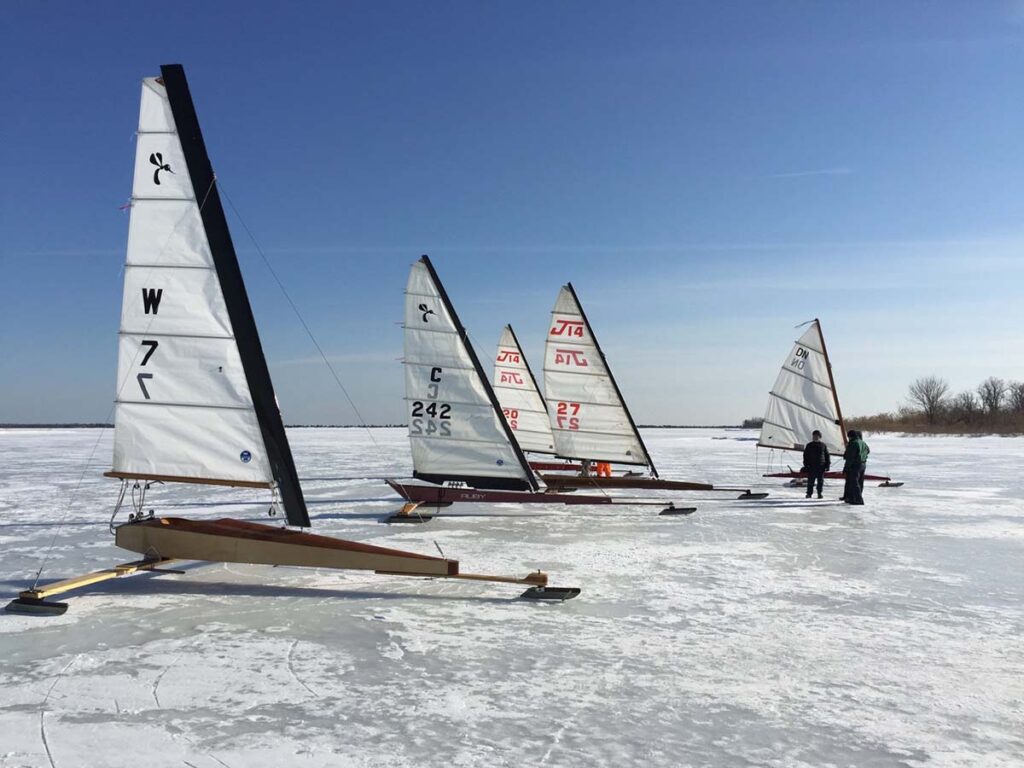
 press-releases
press-releases 

It’s been eight long winters since North Fork waters froze thick enough for iceboats to sail across, and barring an unexpected March deep freeze, the count will soon hit nine. The dearth of freezing weather has gone on so long, the motley crew of area iceboating enthusiasts recently resorted to an age-old — if slightly goofy — Nordic ritual.
On New Year’s Day, a group of diehards, dressed as Norse gods and swarthy Vikings and touting a two-foot-tall Santa Claus statue clad in a Hawaiian shirt, gathered on the shore of Hallocks Bay in Orient. They wielded hockey sticks and swept piles of machine-made ice into the bay, hoping to induce Mother Nature into a deep freeze. In a previous year’s ceremony, they built a little boat, set it on fire and sent it out into the bay.
Photos by Jeremey Garretson:
“We actually didn’t start doing the ritual until after a few years of bad ice,” said Karen Sauvigne of East Marion. “We realized we’ve got to do something.”
Veteran iceboat builder and racer Mike Acebo said the tradition goes way back.
“It’s an old, old thing. Usually it would happen at the [winter] solstice, the changing of the season. They would get together and there were stupid hats and fur coats and hockey sticks and they’d throw ice in [the bay].”
He said the Lake Ronkonkoma Ice Boat and Yacht Club embraced the tradition for years during iceboating droughts.
“Every year they would have a blessing of the lake and a ‘seeding of the ice.’ That’s what they called it. It was like storm cloud seeding, but they were seeding the lake to get it to form ice.”
Photos by: Jeremy Garretson


The thirst to race across the frozen bays dates back centuries on the North Fork.
“During the late 1800s, early 1900s up to [World War I], the farmers had nothing to do in the winter,” Mr. Acebo said. “What were you going to do when your fields were covered with snow? They built old style, stern-steer iceboats … every farmer had an iceboat in the ceiling of his barn.”
The current eight-year drought “is as bad as it’s been” in decades, Mr. Acebo said, citing global warming. “It’s being felt all the way to Maine.”
During an interview this week, Mr. Acebo said that the North American iceboat championships for a class of iceboats known as “DNs” was scheduled to take place in the Northeast this year, but had to be moved to Minnesota “because it’s the only [frozen] lake they could find.”
Despite the long pause, local iceboat racers still yearn for their next ride.
“The first time you try it, and you get going, and there’s a nice breeze and you pull the sail tight, the boat takes off like a jet,” Mr. Acebo said. “That’s the feeling. It pushes you back in the cockpit. The speed is exhilarating. And the speed goes faster and faster and faster and you think you’re doing 100 miles an hour when you’re doing 45.
“I mean, it’s just the most incredible feeling you can have. Now I drive a Porsche. I’ve skied downhill, rafted in the Grand Canyon. I’ve flown gliders. I don’t know what else you want. You know, I rode a motorcycle across the country. This is the most exhilarating thing that I’ve ever done.”
Iceboat enthusiast Richard Gluckman has a vivid memory of his own first exposure to the sport.
“The very first time I ever saw one was here in Orient 20 years ago, maybe more, on Hallocks Bay,” he said. “I had two young daughters, 3 and 5. We walked across the fields and came on to this amazing scene. I’ve never seen anything like it since.
“It was like a Currier & Ives print. Boats that were over 100 years old — 19th-century boats and 20th-century boats … boats of all types, maybe a dozen or so. There were young kids playing hockey, figure skaters figure skating, dogs running back and forth … It was just a beautiful, wonderful winter scene.”
He remembers seeing Mr. Acebo grilling hot dogs and passing them out to all takers.
“People are hanging out in chairs. And it didn’t occur to me that I could do this,” Mr. Gluckman said.
A decade later he tried a friend’s iceboat.
“I was totally hooked,” he said. “I couldn’t believe it. Within a month I bought a nice boat and the first time I sailed it was in Lake Ronkonkoma. I didn’t have a clue what I was doing. So yeah, I did some damage to myself and my boat, but it was really so much fun.”
The first rule of iceboating is to never sail solo. It’s too dangerous, veterans say. The minimum thickness of the ice depends on whether it’s fresh or salt water, along with several other variables, but the general minimum thickness is 4 to 6 inches, which has traditionally been checked by drilling a hole and measuring carefully.
“When we go to a specific area, we scout … and if we find weak spots in the ice — cracks, holes, dangerous spots — we put up red flags to designate those areas to stay away,” Mr. Acebo said.
Experienced iceboaters carry ice picks and throw lines. They wear flotation vests and pull rubber spikes over their boots. A helmet and thick gloves are also essential, as are an extra set of warm clothes in your car in case you go into the drink.
“There’s usually a [rescue] ladder on shore,” Mr. Acebo said, “so that you can go and reach a ladder out to them from solid ice out to the weak ice and into the water and they can get on the ladder and come out.
“Usually getting the people out is the quickest and the easiest, and then somebody will load that person on the runner plank of their boat and sail them in,” he said. “Everybody helps get their clothes off, give them blankets and extra clothes and sit them in a car and turn the heater on. So very rarely have I seen anybody get hypothermia or need to go to the hospital from being immersed.
“But the problem is now getting that iceboat out of the water. These things are awkward. They’re cumbersome. They got three legs sticking out in different directions and a mast sticking out the top — and they don’t necessarily float. And you can’t just walk up to the edge of the ice because you’ll fall in. So that becomes a whole rescue procedure that takes five, six, seven, eight people to get an iceboat out and it could take hours to do it.”
Mr. Acebo said global warming may ultimately put an end to iceboating on local lakes and bays.
“I’ve watched the sea level gradually come up higher and higher on the bulkheads, [watched] storms overrun the bulkheads and get into the parking lots get into the buildings. For 30 years I watched it happen.
“Back then we iceboated here, but gradually — every five years — we got fewer weeks of sailing and ice boating, and then eventually … since 2015, we have not once sailed on the North Fork on ice. It hasn’t happened.”
24World Media does not take any responsibility of the information you see on this page. The content this page contains is from independent third-party content provider. If you have any concerns regarding the content, please free to write us here: contact@24worldmedia.com